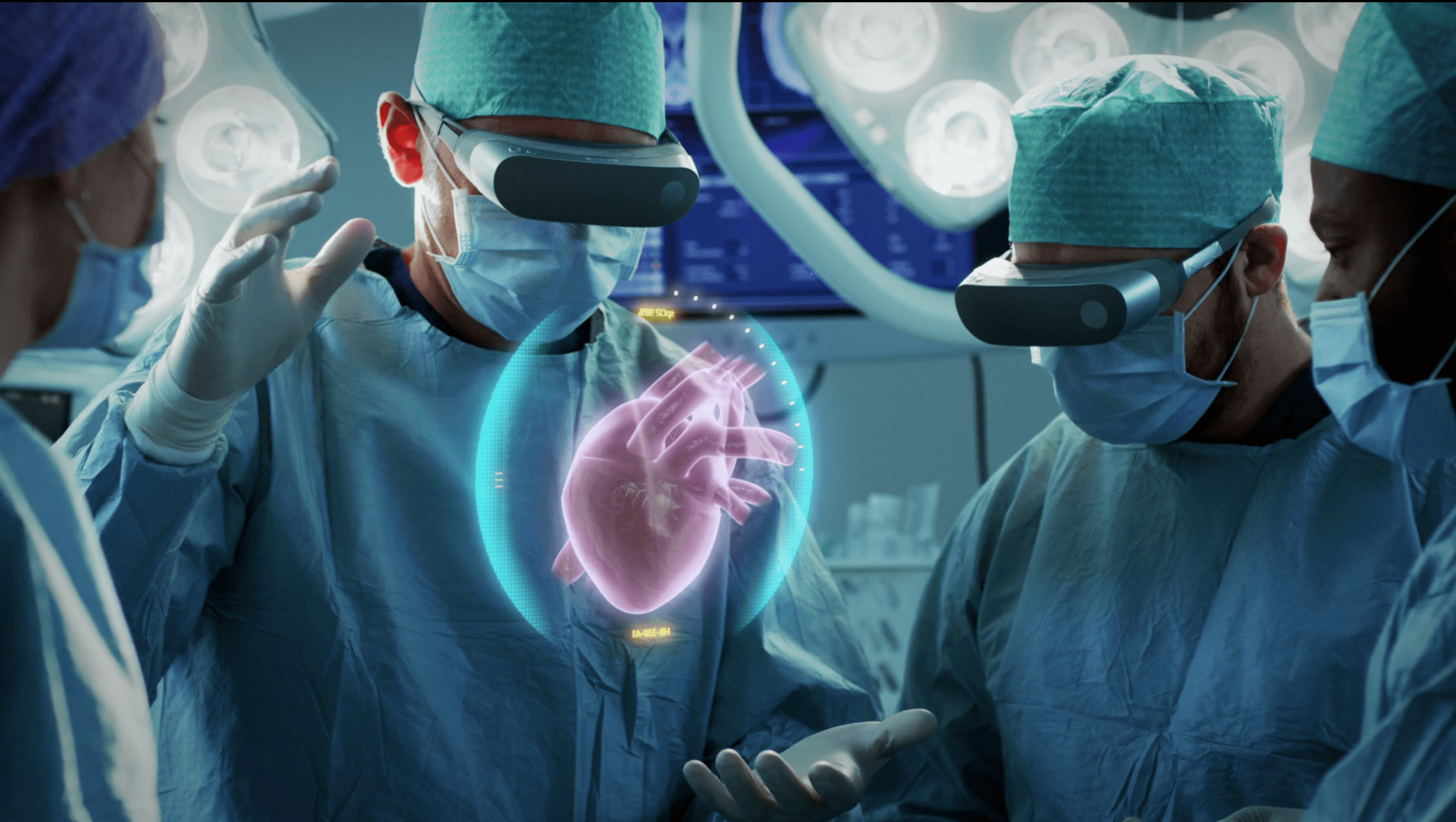TECHNOLOGY
Use Cases of AR and VR in Healthcare

The stakes in the healthcare industry are high as it is directly related to the well-being of humans.
Integrating technologies such as AR and VR in healthcare can pave the way for better health results, providing more precise and accurate solutions.
ome time ago, Virtual Reality and Augmented Reality technologies were limited to the gaming industry. Now, as the world all around is becoming more digitized, many industries are integrating the technologies of AR and VR in their workings and achieving what seemed a far-fetched reality. One such industry is healthcare. It is reported that the market for AR and VR in healthcare is going to reach around 9.7 billion dollars in the coming five years. The current value is approximately 2.7 billion dollars. This means that the industry will grow 3.5 times by the year 2027.
All healthcare systems come with their own set of challenges. Issues could range from the patient being situated in a difficult-to-access area or having limited availability of space and equipment, and skills. Some equipment may be outdated or obsolete, which makes the practitioner’s task quite difficult and can endanger the patient. One perpetual challenge is the lack of availability of staff. Training and educating medical practitioners require a lot of time, and they can’t be asked to jump into any cases in real-life until and unless they have the required skills. However, a lot of these problems can be mitigated if AR and VR technologies come into play. AR and VR-powered tools can empower doctors to understand complex procedures and perform them on the patient. Educating and training professionals can also be simplified using immersive technologies as it will provide a near-real simulation and a broader understanding and knowledge of the human body.
These technologies can also significantly improve the experience of a patient and a doctor by adding navigation features and pop-up information. This allows the patients to help locate where they can find the particular doctor. AR and VR-enabled applications can critically improve the overall effectiveness of medical services.
How Can AR and VR in Healthcare Be Effective
There is a rise in the use of VR and AR technologies in medical education. Surgeons, doctors and medical students can learn to effectively execute their patients’ complex surgeries and not subject them to any risks.

1. Body Mapping
There are frequent situations where surgeons are faced with complex surgery. In such cases, they need to be absolutely sure that they will be able to perform the surgery. Using AR and VR technology helps to create an exact simulation of the body that needs to be operated on, and the surgeons can experiment with the complicated procedures to figure out the best way. It can also aid in case the doctor cannot examine the body physically. This helps to provide the patient with the best possible result while keeping them out of danger.
2. Remote Collaboration
Applications of AR and VR offer remote collaboration between multiple doctors and smoothen the consultation process by detecting the issue faced by the patient accurately. They also provide conferences and collaborative remote surgeries between medical practitioners based out of different locations working on related medical problems. One such technology is called Proximie. It allows doctors to scrub in virtually during surgery and provides the surgeons with virtual hands-on assistance.
3. Medical Education Through Simulation
One of the major challenges that the healthcare industry faces is the lack of trained and skilled professionals. Implementing AR and VR solutions can ease the entire process of educating and training. VR is an effective way of studying and understanding the human anatomy by going through each layer and also understanding how it functions. VR enables training as it helps to simulate real-life conditions and train professionals for real-life challenges and complexities.
4. Precise Disease and Risk Assessment
Applications that are AR-powered assist doctors in identifying and treating various diseases with enhanced diagnosis. They help to collect information from different sensors in a single interface and provide visualization to understand the exact reasons for the patient’s symptoms. They also allow us to monitor and examine organs, veins, etc., without doctors needing to conduct invasive procedures.
5. Psychological Treatments
The use of immersive technologies such as virtual and augmented reality also helps in providing psychological relief and treatments. Specific virtual environments can be created to help patients plagued by certain mental conditions such as phobias, addictions, or anxiety. One such application is Oxford VR. It allows patients with any psychological disorders and provides them with a safe environment to overcome them, as it is done virtually. These VR simulations will help to understand the patterns of these disorders and help to develop targeted treatments for such patients. It can also pave the way to reducing pain and improving the patient’s sleeping patterns.
6. Augmented Surgery
To help improve the safety of patients, AR-powered applications provide surgeons with real-time data about the patient’s vitals, the details of the procedure, the required equipment, and other required information. These AR-enabled virtual interfaces help surgeons to visualize and locate the tumor, abnormalities, or any other diseases. This helps to quicken the procedure while keeping the patients out of danger.
7. Access to Patient’s Symptoms
Applications powered by AR/VR can allow doctors to access multiple simulations of particular medical conditions and help to reduce the number of errors in the prognosis and patient visits. Numerous diseases can be cured and prevented accurately via AR-powered mobile applications, which also makes patients self-sufficient in taking the necessary cautionary measures while in the process of recovery. This increases the ratio in patient consultation with the time taken and avoids unnecessary doctor visits various times a week.
8. Consultation
AR/VR-powered applications allow doctors to provide in-person consultation during emergencies or pandemic situations. Essential services like vitals monitoring, immediate remedies, pulse examination, poisoning cure, etc., can be delivered virtually. If a person is experiencing any discomfort, the same can be checked out using AR-powered tools to help the patient and doctor save time and energy.
The Healthcare industry has been one of the most impacted industries when it comes to implementing technologies and yet is slow to embrace VR and AR due to challenges such as lack of awareness and insufficient finances. However, as the years progress, implementation and investment in these immersive technologies in the medical industry are going to become a reality. If implemented correctly, AR and VR in healthcare can be a great boon. Teaching and training medical professionals will also become simplified yet enhanced. Consulting with a doctor will become convenient, and the pressure of diagnosing patients will reduce. Doctors can also collaborate on complex but related procedures, provide the patient with the best possible result, and achieve successful surgery. Immersive technologies such as AR and VR will truly revolutionize the healthcare industry and make the lives of doctors and patients simpler and more convenient.
Source link
TECHNOLOGY
Next-gen chips, Amazon Q, and speedy S3

AWS re:Invent, which has been taking place from November 27 and runs to December 1, has had its usual plethora of announcements: a total of 21 at time of print.
Perhaps not surprisingly, given the huge potential impact of generative AI – ChatGPT officially turns one year old today – a lot of focus has been on the AI side for AWS’ announcements, including a major partnership inked with NVIDIA across infrastructure, software, and services.
Yet there has been plenty more announced at the Las Vegas jamboree besides. Here, CloudTech rounds up the best of the rest:
Next-generation chips
This was the other major AI-focused announcement at re:Invent: the launch of two new chips, AWS Graviton4 and AWS Trainium2, for training and running AI and machine learning (ML) models, among other customer workloads. Graviton4 shapes up against its predecessor with 30% better compute performance, 50% more cores and 75% more memory bandwidth, while Trainium2 delivers up to four times faster training than before and will be able to be deployed in EC2 UltraClusters of up to 100,000 chips.
The EC2 UltraClusters are designed to ‘deliver the highest performance, most energy efficient AI model training infrastructure in the cloud’, as AWS puts it. With it, customers will be able to train large language models in ‘a fraction of the time’, as well as double energy efficiency.
As ever, AWS offers customers who are already utilising these tools. Databricks, Epic and SAP are among the companies cited as using the new AWS-designed chips.
Zero-ETL integrations
AWS announced new Amazon Aurora PostgreSQL, Amazon DynamoDB, and Amazon Relational Database Services (Amazon RDS) for MySQL integrations with Amazon Redshift, AWS’ cloud data warehouse. The zero-ETL integrations – eliminating the need to build ETL (extract, transform, load) data pipelines – make it easier to connect and analyse transactional data across various relational and non-relational databases in Amazon Redshift.
A simple example of how zero-ETL functions can be seen is in a hypothetical company which stores transactional data – time of transaction, items bought, where the transaction occurred – in a relational database, but use another analytics tool to analyse data in a non-relational database. To connect it all up, companies would previously have to construct ETL data pipelines which are a time and money sink.
The latest integrations “build on AWS’s zero-ETL foundation… so customers can quickly and easily connect all of their data, no matter where it lives,” the company said.
Amazon S3 Express One Zone
AWS announced the general availability of Amazon S3 Express One Zone, a new storage class purpose-built for customers’ most frequently-accessed data. Data access speed is up to 10 times faster and request costs up to 50% lower than standard S3. Companies can also opt to collocate their Amazon S3 Express One Zone data in the same availability zone as their compute resources.
Companies and partners who are using Amazon S3 Express One Zone include ChaosSearch, Cloudera, and Pinterest.
Amazon Q
A new product, and an interesting pivot, again with generative AI at its core. Amazon Q was announced as a ‘new type of generative AI-powered assistant’ which can be tailored to a customer’s business. “Customers can get fast, relevant answers to pressing questions, generate content, and take actions – all informed by a customer’s information repositories, code, and enterprise systems,” AWS added. The service also can assist companies building on AWS, as well as companies using AWS applications for business intelligence, contact centres, and supply chain management.
Customers cited as early adopters include Accenture, BMW and Wunderkind.
Want to learn more about cybersecurity and the cloud from industry leaders? Check out Cyber Security & Cloud Expo taking place in Amsterdam, California, and London. Explore other upcoming enterprise technology events and webinars powered by TechForge here.
TECHNOLOGY
HCLTech and Cisco create collaborative hybrid workplaces

Digital comms specialist Cisco and global tech firm HCLTech have teamed up to launch Meeting-Rooms-as-a-Service (MRaaS).
Available on a subscription model, this solution modernises legacy meeting rooms and enables users to join meetings from any meeting solution provider using Webex devices.
The MRaaS solution helps enterprises simplify the design, implementation and maintenance of integrated meeting rooms, enabling seamless collaboration for their globally distributed hybrid workforces.
Rakshit Ghura, senior VP and Global head of digital workplace services, HCLTech, said: “MRaaS combines our consulting and managed services expertise with Cisco’s proficiency in Webex devices to change the way employees conceptualise, organise and interact in a collaborative environment for a modern hybrid work model.
“The common vision of our partnership is to elevate the collaboration experience at work and drive productivity through modern meeting rooms.”
Alexandra Zagury, VP of partner managed and as-a-Service Sales at Cisco, said: “Our partnership with HCLTech helps our clients transform their offices through cost-effective managed services that support the ongoing evolution of workspaces.
“As we reimagine the modern office, we are making it easier to support collaboration and productivity among workers, whether they are in the office or elsewhere.”
Cisco’s Webex collaboration devices harness the power of artificial intelligence to offer intuitive, seamless collaboration experiences, enabling meeting rooms with smart features such as meeting zones, intelligent people framing, optimised attendee audio and background noise removal, among others.
Want to learn more about cybersecurity and the cloud from industry leaders? Check out Cyber Security & Cloud Expo taking place in Amsterdam, California, and London. Explore other upcoming enterprise technology events and webinars powered by TechForge here.
TECHNOLOGY
Canonical releases low-touch private cloud MicroCloud

Canonical has announced the general availability of MicroCloud, a low-touch, open source cloud solution. MicroCloud is part of Canonical’s growing cloud infrastructure portfolio.
It is purpose-built for scalable clusters and edge deployments for all types of enterprises. It is designed with simplicity, security and automation in mind, minimising the time and effort to both deploy and maintain it. Conveniently, enterprise support for MicroCloud is offered as part of Canonical’s Ubuntu Pro subscription, with several support tiers available, and priced per node.
MicroClouds are optimised for repeatable and reliable remote deployments. A single command initiates the orchestration and clustering of various components with minimal involvement by the user, resulting in a fully functional cloud within minutes. This simplified deployment process significantly reduces the barrier to entry, putting a production-grade cloud at everyone’s fingertips.
Juan Manuel Ventura, head of architectures & technologies at Spindox, said: “Cloud computing is not only about technology, it’s the beating heart of any modern industrial transformation, driving agility and innovation. Our mission is to provide our customers with the most effective ways to innovate and bring value; having a complexity-free cloud infrastructure is one important piece of that puzzle. With MicroCloud, the focus shifts away from struggling with cloud operations to solving real business challenges” says
In addition to seamless deployment, MicroCloud prioritises security and ease of maintenance. All MicroCloud components are built with strict confinement for increased security, with over-the-air transactional updates that preserve data and roll back on errors automatically. Upgrades to newer versions are handled automatically and without downtime, with the mechanisms to hold or schedule them as needed.
With this approach, MicroCloud caters to both on-premise clouds but also edge deployments at remote locations, allowing organisations to use the same infrastructure primitives and services wherever they are needed. It is suitable for business-in-branch office locations or industrial use inside a factory, as well as distributed locations where the focus is on replicability and unattended operations.
Cedric Gegout, VP of product at Canonical, said: “As data becomes more distributed, the infrastructure has to follow. Cloud computing is now distributed, spanning across data centres, far and near edge computing appliances. MicroCloud is our answer to that.
“By packaging known infrastructure primitives in a portable and unattended way, we are delivering a simpler, more prescriptive cloud experience that makes zero-ops a reality for many Industries.“
MicroCloud’s lightweight architecture makes it usable on both commodity and high-end hardware, with several ways to further reduce its footprint depending on your workload needs. In addition to the standard Ubuntu Server or Desktop, MicroClouds can be run on Ubuntu Core – a lightweight OS optimised for the edge. With Ubuntu Core, MicroClouds are a perfect solution for far-edge locations with limited computing capabilities. Users can choose to run their workloads using Kubernetes or via system containers. System containers based on LXD behave similarly to traditional VMs but consume fewer resources while providing bare-metal performance.
Coupled with Canonical’s Ubuntu Pro + Support subscription, MicroCloud users can benefit from an enterprise-grade open source cloud solution that is fully supported and with better economics. An Ubuntu Pro subscription offers security maintenance for the broadest collection of open-source software available from a single vendor today. It covers over 30k packages with a consistent security maintenance commitment, and additional features such as kernel livepatch, systems management at scale, certified compliance and hardening profiles enabling easy adoption for enterprises. With per-node pricing and no hidden fees, customers can rest assured that their environment is secure and supported without the expensive price tag typically associated with cloud solutions.
Want to learn more about cybersecurity and the cloud from industry leaders? Check out Cyber Security & Cloud Expo taking place in Amsterdam, California, and London. Explore other upcoming enterprise technology events and webinars powered by TechForge here.
-

 PPC5 days ago
PPC5 days ago19 Best SEO Tools in 2024 (For Every Use Case)
-

 MARKETING7 days ago
MARKETING7 days agoStreamlining Processes for Increased Efficiency and Results
-
SEARCHENGINES7 days ago
Daily Search Forum Recap: April 17, 2024
-

 SEO7 days ago
SEO7 days agoAn In-Depth Guide And Best Practices For Mobile SEO
-
SEARCHENGINES6 days ago
Daily Search Forum Recap: April 18, 2024
-

 MARKETING6 days ago
MARKETING6 days agoEcommerce evolution: Blurring the lines between B2B and B2C
-
SEARCHENGINES5 days ago
Daily Search Forum Recap: April 19, 2024
-

 SEO6 days ago
SEO6 days ago2024 WordPress Vulnerability Report Shows Errors Sites Keep Making
















You must be logged in to post a comment Login